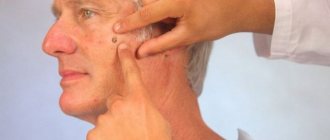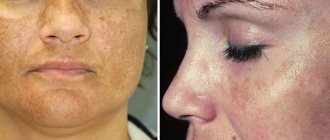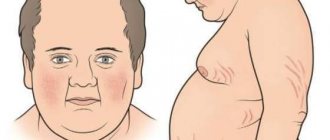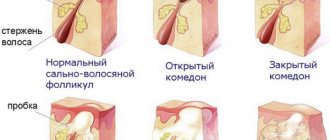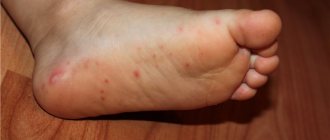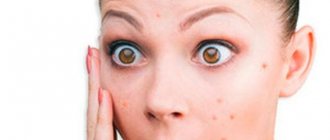Black dots on the fingers are a symptom indicating dermatological diseases or malfunctions of internal organs. Such neoplasms often arise due to excessive pigmentation of the skin, blockage of follicles with natural fat, or a viral or fungal infection. If spots appear on your hands, you should consult a dermatologist. Some of them do not pose a threat to health, while others indicate the appearance of benign or malignant tumors.
Causes and types of black dots on fingers
Any changes in the condition of the skin are grounds for contacting a doctor. Most often, a blackhead on the hand occurs due to excessive production of melanin by pigment cells. Such neoplasms do not pose a threat to health and do not cause any complications. But in some cases, darkened areas are formed due to infections and other pathological processes in the skin.
Factors that provoke the formation of dots include:
- blockage of skin pores with horny masses;
- papilloma virus;
- hormonal imbalance;
- acrocyanosis;
- autoimmune disorders;
- excessive sweating of hands;
- use of low-quality cosmetics;
- medication abuse;
- intoxication of the body.
Black spots on the skin can have different etiologies (causes of occurrence) and symptoms. Most often they are:
- warts;
- open comedones;
- melanoma;
- birthmarks;
- foci of folliculitis;
- malignant tumors.
To exclude dangerous diseases, if pinpoint spots appear on the fingers, they are examined by a dermatologist. Timely treatment reduces the risks of complications and the need for surgery.
Open comedones
One of the most common causes of blackheads is open comedones.
These skin lesions can plague both women and men starting in adolescence. Morphologically, they are closed ducts of the sebaceous glands, in which secretions and dead epithelial cells accumulate.
They are cysts that are formed as a result of blockage of the mouth of the hair follicles by keratinized epidermal cells, natural fat, and dust. Black comedones most often occur on the arms, face, back and ears. The formation of fatty plugs in skin pores can be provoked by:
- failure to comply with hygiene rules;
- hyperactivity of the sebaceous glands;
- increased sweating;
- low-quality cosmetics;
- disruption of keratinization processes (exfoliation of dead skin particles);
- disruptions in the gastrointestinal tract;
- liver diseases;
- medication abuse;
- hormonal imbalance.
Such points on the fingers do not cause discomfort and very rarely become inflamed. When pressed, dense dark yellow masses are released from them.
Warts
Sometimes black spots on the palms and fingers are caused by the human papillomavirus. Warts are benign tumors that tend to grow. The infection is transmitted through household contact when communicating with a sick person or through household items. Factors that provoke the formation of black tumors on the hands include:
- neuroses;
- decreased body resistance;
- psycho-emotional stress;
- insufficient blood supply to small capillaries;
- excessive sweating of the palms.
Common, or vulgar, warts often appear on the fingers. They are dry and dense black dots that rise above the surface of the skin.
Only a qualified dermatologist can determine whether a wart is harmless. It is not uncommon for skin cancers, i.e. melanomas, to look almost like a wart, so if such formations appear, you should consult a doctor.
Over time, the formations merge with each other, forming large plaques.
Pigment formations
The appearance of black spots on the fingers is often associated with prolonged exposure to UV rays. Active production of melanin by pigment cells leads to the appearance of characteristic dots of red, purple, black or dark brown. Moles are located at the level of the skin or rise above it. Almost all people aged 10-12 years have such neoplasms.
The causes of various formations of foci of age spots on the hands are often due to the presence of the most unexpected background internal pathological conditions of the body.
The main causes of pigment spots include:
- radiation exposure;
- viral infections;
- exposure to ultraviolet radiation;
- hormonal imbalances;
- skin injuries.
If nodular formations appear on the spots or they quickly increase in size, you need to consult a dermatologist. Such symptoms may indicate the development of a malignant tumor from pigment cells (melanocytes). Melanoma rapidly progresses and metastasizes to internal organs through the hematogenous or lymphogenous route, that is, through the blood or lymph.
Folliculitis
An infectious disease can be parasitic, viral, mycotic (fungal) or bacterial in nature. It occurs as a result of infection of the hair follicles, which is why first dots and then pustules or ulcers form on the skin.
Where do dark spots under nails come from and how to get rid of them? Recommendations and preventive measures
By the appearance of a person’s nail plate, one can recognize not only his occupation, but also possible pathologies in the body.
Nails signal health problems before the main symptoms appear. Therefore, the appearance of spots is not only a cosmetic problem, but also a medical one.
The reasons why dark spots may appear on the nail plates of the feet and hands - on the thumbs and fingers - do not depend on age, gender or social status.
Most often, the appearance of such a defect on the legs and arms may mean that a disease is present.
The list of diseases is relative and does not always suit the same patient. It is necessary to conduct a complete examination of the body to make an accurate diagnosis.
- Endocarditis and other diseases of the cardiovascular system.
- The spot looks like a hematoma, but there were no trauma factors.
- Liver problems: cirrhosis, hepatitis and others.
- Melanoma. The spot increases in size and gradually begins to appear on the skin. This indicates the possibility of growth of a malignant tumor - melanoma.
- Poor nutrition and vitamin deficiency. Spots appear on the nails of both hands and feet. They signal that the body lacks folic acid, protein, vitamin B12, and other vitamins. With this pathology, in addition to dark spots, brittle and brittle nails are observed.
- Diabetes. The appearance of spots is associated with metabolic disorders and trophic changes in tissues.
- Kidney failure.
- Hemangioma. A benign tumor forms under the nail plate and is dark brown in color. It does not cause pain and sometimes goes away on its own.
- Hyperpigmentation. It is temporary and occurs in people sensitive to chemicals, ultraviolet rays and low-quality cosmetics.
- Poor nail care, poor quality manicure and pedicure. If there is any change in the color or integrity of the nail plate, you must consult a doctor without delay and do not self-medicate.
Infections
- Fungal infection is the most likely and common cause of dark-colored defects.
The pathology is manifested by the following symptoms:- crumbling edge of the nail;
dark spots on the nails that turn into yellow, or vice versa, yellow that turns into dark;
- unpleasant odor;
- abnormal nail growth;
- destruction of the nail plate.
- A bacterial infection most often appears dark green, but can also be dark brown.
Pseudomonas aeruginosa and mold spores are the most common pathogens of bacterial infections.Bacterial infection spreads most often under loose nails.
During drug therapy the following is required:
- avoid wearing open shoes;
do not walk barefoot;
- clean your nails from dirt and follow the rules of hygiene;
- Do not share socks or shoes with someone else.
It is easy to catch a fungal infection in public places with high levels of humidity (sauna, swimming pool), as well as when using someone else's shoes and personal hygiene products.
The therapy lasts a long time and treatment is carried out locally until all symptoms completely disappear and a new nail grows.
The duration of treatment and recovery depend on how the patient follows the recommendations.
Injuries
During the impact, the capillaries under the nail plate are damaged, and a dark-colored spot is formed - a hematoma.
If the injury causes severe pain and inflammation that gets worse, you should consult a doctor immediately.
If the blow was strong, then the hematoma can provoke an accumulation of fluid under the nail , which will cause purulent inflammation. It is possible to get rid of it using resection or puncture.
In case of severe injury, removal of the nail plate is indicated.
The cause of darkening can also be a small bruise or blow, which brings almost no pain. Over time, the hematoma resolves. The use of special ointments is indicated.
Uncomfortable shoes
When wearing uncomfortable shoes, the risk of not only getting dark spots on the nails due to compression of certain parts of the limb increases, but also of contracting a fungal infection.
Sweating in uncomfortable shoes causes increased humidity and heat. And they accelerate the process of growth and reproduction of bacteria. Therefore, fungal infections are a very common occurrence when wearing tight and uncomfortable shoes.
If you change it, the dark spots on the nail plate will disappear in 2-3 weeks without treatment.
Pregnancy
During pregnancy, dark spots on the nails may appear due to hormonal changes in the body and disruption of normal metabolic processes.
This condition is the norm, not a deviation. All symptoms will disappear after childbirth.
Methods for treating the nail plates of the hands and feet
To prescribe the correct therapy, it is necessary to determine the underlying disease that causes darkening of the nail plate.
Treatment includes:
- taking medications;
- physiotherapy;
- therapeutic nutrition;
- traditional medicine methods;
- taking vitamin complexes.
Folk remedies
Home treatments do not help with all types of stains. Most of them need to be treated in tandem with a doctor or in a hospital setting after the cause is determined.
Traditional medicine:
- Vinegar. Compresses and baths are made from it, and hands or feet are kept in the solution for some time. Vinegar must be mixed with water 1:1. To obtain the result, you must do the procedure at least three times.
- Tea tree oil. The antiseptic properties of essential oil make it an excellent assistant in the fight against dark spots on nails. Dilute 3–5 drops of oil in half a glass of warm water and soak your nails in the liquid.
- Baking soda . The powder should be dissolved in warm water and baths should be made. Soda is an excellent antiseptic. After a vinegar bath, you should soak your nails in a soda solution.
- Sea salt. Add to water for baths. It is better to use salt without additives or flavorings.
Medicines
Drug treatment is prescribed after diagnosis, depending on the underlying disease:
- In case of injury, it is necessary to apply cold to the sore spot and apply heparin ointment. To quickly resolve the hematoma, Traumeel ointment and Troxevasin gel are used.
- In case of pathologies of internal organs, the source must be treated.
- Fungal infections are treated with antimycotics:
- "Mikoma";
- "Diflucan".
"Irunin";
External treatment of the affected areas with ointments containing antifungal components (Exoderil or Ciclopirox) is also necessary. To soften tissues, preparations with salicylic and lactic acids are often used.
If a fungus is diagnosed, then a diet excluding sweets, flour and dairy products is indicated.
At the first appearance of a change in the shade of the nail plate, you should seek advice from:
- dermatologist;
- therapist;
- gastroenterologist;
- nephrologist.
And undergo a full examination of the body with all necessary tests.
Prevention of darkening of the nail is to maintain the general health of the body:
- Regular medical examination and basic tests.
- Healthy lifestyle - quitting smoking, alcohol and drugs.
- Maintaining a daily routine.
- Regular nail care.
- Review your diet and add foods rich in antioxidants.
- Refusal of trimmed manicure and pedicure in favor of hardware.
- Compliance with personal hygiene rules.
- Minimize the use of dark colored nail polishes.
- Taking vitamin and mineral complexes.
- Review your shoes and discard those that cause discomfort.
- Do not wear someone else's shoes, socks or tights.
Nails are a litmus test for the whole body . Even the slightest changes can signal that negative changes are occurring in the body.
Trying to identify a disease on your own is not always a good idea. It is better to seek help from professionals and get the opportunity to stop unwanted processes occurring in the body at an early stage.
The prognosis of treatment depends on the cause that provoked the pathology. After eliminating it and following the doctor’s instructions, a healthy nail of a natural shade will grow back within 6–9 months.
Source: https://idealnyi-manikur.ru/articles/lechenie-nogtej/temnye-pyatna.html
How to treat
The cause of the formation of pinpoint rashes on the fingers are both infections and pathologies of internal organs. Only a specialist can determine a treatment strategy after making a diagnosis.
Drug treatment
Black warts on the hands are treated with topical medications that include salicylic acid, potassium hydroxide, retinoic acid, phenol and fluorouracil. For the treatment of folliculitis and other infectious diseases, the following are used:
- antibiotics;
- antiviral drugs;
- antimycotics;
- keratolytics (exfoliating);
- immunostimulants.
Pigment dots indicate disturbances in the functioning of internal organs. Therefore, treatment consists of taking medications, the action of which is aimed at correcting their functions. Malignant tumors are treated with chemotherapy and immunostimulating agents.
Operation
Surgical intervention is indicated when drug therapy is ineffective, or the formation of benign or malignant tumors. To treat warts, they resort to radio wave surgery and freezing with liquid nitrogen. For melanoma, the tumors are completely excised, after which the patient is prescribed radiation therapy and alpha-interferon to prevent relapses. Moles are removed with a laser or electric needle.
ethnoscience
Alternative medicine cannot be used as the only treatment. They are used as an adjunct to medication. To combat warts, it is recommended to use:
- onion;
- celandine juice;
- spurge;
- spring buttercup;
- ordinary rowan.
To eliminate open comedones, use a local irritant. Ammonia or ammonia expands the skin pores, which helps the fat plugs to come out of them. To prepare a medicinal solution, you need to mix 1 tsp. products with 200 ml of boiled water. In addition, it is recommended to use milk-gelatin ointments and lemon juice.
A decoction of parsley and celandine discolors pigment spots, and infusions of calendula, chamomile and sage reduce the severity of inflammation in folliculitis. To restore the barrier function of the skin and prevent black spots on the skin, it is recommended to wash your hands with tar soap or rinse them with a decoction of St. John's wort.
Other methods
The success of treatment of dermatological diseases depends on careful personal hygiene.
Black spots on the skin of the hands are most often a sign of illness, a problem in the functioning of the body, so the best thing you can do is to seek help from a dermatologist.
Preventive measures
As you know, any disease is easier to prevent than to fight it. To prevent the occurrence of such growths - warts, moles, melanomas - experts recommend proper skin care. Preventive measures in this case can be considered:
- Using sunscreen when visiting a solarium or the beach.
- It is necessary to thoroughly dry the body with a towel after water procedures. Especially after swimming in the sea. Water tends to enhance the effect of ultraviolet radiation on the skin.
- You should not sunbathe excessively on the beach and often visit the solarium.
These tips and safety precautions are especially relevant for people with fair skin.
It is believed that pigment spots on a woman’s hands can appear with age. This opinion is widespread and erroneous, because a brown spot, a whole scattering of marks, can appear at absolutely any age. The reasons for the appearance of spots are not only age-related, they are associated with hormonal characteristics, skin reactions, allergies, and even general phenotypic characteristics. However, dark spots can be removed.
Prevention
There is no specific prevention of black spots on the fingers, since their appearance is caused by the influence of many external and internal factors. To reduce the risk of stains:
- comply with sanitary and hygienic rules;
- treat gastrointestinal and liver diseases in a timely manner;
- avoid using other people's hygiene products;
- take immunostimulating drugs.
If you find characteristic spots on your hands, you should contact a dermatologist. An increase in their size and the appearance of additional symptoms often indicates serious illness.
Diagnosis of health using fingernails. Photo
Diagnosis using fingernails is a method with a long history. Even in Tibet, and even in Ancient China, doctors perfectly mastered the science of determining the state of health by nails.
Modern doctors confirm that the condition of the nails can indicate the beginning of problems in the body, even when serious diseases are far away.
There is a direct correlation: nails - health - nail diagnostics will help you find emerging problems, especially if you use several nail diagnostic methods at once.
We carry out diagnostics ourselves
Ideally, the nail plate should be smooth, without grooves, tubercles, cracks or spots. The nail should not be white or peeling.
Take a closer look at your plates. If they grow poorly or break, it means your diet lacks nutrients and minerals.
Eat foods rich in calcium products.
Along the nail hole
Since ancient times it was believed that each nail is associated with a specific organ.
Diagnosis of health using fingernails begins with the holes: it is the nail holes that will first of all tell you which organ in your body is at risk and which doctor you should make an appointment with.
If at least one hole is absent on the fingers, it indicates a decrease in hemoglobin and red blood cells (anemia, anemia).
If the holes in your nails have become thinner or completely disappeared:
- Thumb – brain and skull. The ancients believed that if the hole on this finger disappeared, it meant that the person had serious problems with his head.
- Index – large intestine, liver and lungs, as well as inflammation and gynecological diseases. If the hole becomes smaller or disappears completely, urgently pay attention to the intestines, liver and pancreas!
- Medium – a disease of the circulatory system. If there is no hole, there is a problem with pressure and blood vessels.
- Unnamed - the hole reflects the state of metabolism and the lymphatic system.
- Little finger – problems with the cardiovascular system or small intestine.
This scheme is confirmed by an interesting observation. For most people, the most noticeable and lightest hole is on the thumbs, and this is no coincidence.
Moles
Small dots on the skin of the hands can be the beginning of the development of moles. Take a closer look, at first they are painted in a rich red color, however, they are barely noticeable. If the process of transformation has begun, the point grows and takes on a different color - consult a doctor immediately and do not make your own decision about treatment with the traditional method. A change in the size, shape, or color of a mole is the first sign of the development of melanoma. The disease originates from moles that already exist on the skin. Be carefull!
What does nodular melanoma look like?
Splinter melanoma
What is red band melanoma?
Source: The first two photos are kindly provided by Dr. Gouyen Wang at the Department of Soft Tissue Cancer, Tianjin Cancer Center, Tianjin Medical University; Third photo courtesy of a pediatric acral melanoma patient. It is often found on the face of middle-aged and elderly people who have experienced sun damage.
Warts
Warts acquire a black color as a result of a disease of blood clots that accumulate in the vessels. Dark spots predominantly form on the hands of older people. In the younger generation, warts acquire a black color after living on the skin for a long time. Warts by their nature are benign growths. However, the sudden appearance of such formations should alert you and serve as a reason for a visit to a dermatologist.
Black dots under fingernails: what to do?
This type of melanoma occurs in all parts of the skin, including the soles of the feet, on the palms of the hands, between the fingers and toes, and under the fingers and nails. Cutaneous melanoma can be described in the following ways. It usually occurs in a previously benign mole and is most often found on the trunk and back in men, and on the legs and back in women.
What does superficial spreading melanoma look like?
Over time, the pigmentation may darken or lighten, the area may become itchy, or the lesion may grow and develop in increasingly irregular borders. Check out our melanoma photos for more examples. Unfortunately, this is the most aggressive type of melanoma. It is more common in men and can occur at any age, but is most often seen in those aged 60 years and older.
Treatment of warts is carried out in a clinical setting using a laser, liquid nitrogen, electric needle or radio waves. In addition to the surgical treatment method, the doctor may prescribe a local medication.

